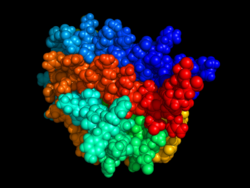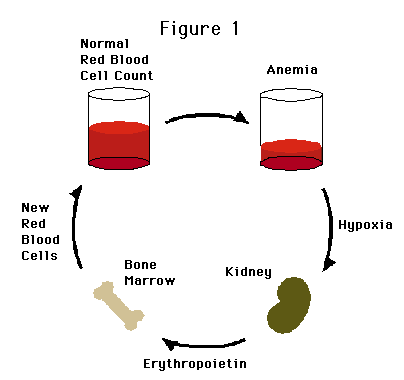 Erythropoietin (EPO) is a naturally occurring protein hormone produced by specialized cells in the kidneys & liver. These cells are sensitive to the oxygen concentration in the blood, and increase the release of EPO when the oxygen concentration is low (hypoxia ). Since oxygen is carried by red blood cells, too few red blood cells (anemia ) will result in erythropoietin release. EPO is a cytokine for stem cells in the bone marrow causing them to increase the production of erythrocytes (red blood cells).
Erythropoietin (EPO) is a naturally occurring protein hormone produced by specialized cells in the kidneys & liver. These cells are sensitive to the oxygen concentration in the blood, and increase the release of EPO when the oxygen concentration is low (hypoxia ). Since oxygen is carried by red blood cells, too few red blood cells (anemia ) will result in erythropoietin release. EPO is a cytokine for stem cells in the bone marrow causing them to increase the production of erythrocytes (red blood cells).
Recombinant erythropoietin
Recombinant erythropoietin is a therapeutic agent produced by DNA technology in mammalian cell culture.Recombinant human erythropoietinIn the 1980s, Adamson, Joseph W. Eschbach, Joan C. Egrie, Michael R. Downing and Jeffrey K. Browne conducted a clinical trial at the Northwest Kidney Centers for a synthetic form of the hormone, Epogen produced by Amgen. A synthetic form of erythropoietin was produced by DNA technology and it became available for use. It is virtually identical to the naturally occurring hormone. There are five erythropoiesis-stimulating agents currently available; epoetin-alpha, epoetin-beta, epoetin-omega, epoetin-delta, and darbepoetin-alpha.
What is EPO primarily used for?
- Kidney disease patients : Recombinant human erythropoietin was first approved as an adjunct in the treatment of kidney disease patients on hemodialysis, in whom anemia is an inevitability due to both the disease and the dialysis.
- AIDS patients : Approval was also given for it to be given to AIDS patients on AZT (ziduvidene).
- Red cell production : Its use is increasing in preoperative and postoperative settings to stimulate the surgical patient's red cell production.
- Acute surgical and post-op : It may be of benefit in acute surgical settings, and may permit more rapid recovery in the post-op period. In particular, it may be a useful adjunct following perioperative hemodilution.
- Chemotherapy : It is also gaining currency in the treatment of anemia secondary to chemotherapy for cancer.
- Blood transfusion alternative : In many clinical settings EPO may be used to reduce or even eliminate the need for blood transfusion. It can be used in neonates for treatment of anemia of prematurity.
- Other potential benefits : There is evidence to show that, in addition to boosting RBC production, EPO may have a positive effect on platelet and leukocyte production.
- PO has also demonstrated a tissue-protective ability, of particular benefit in chronic heart failure and neurological damage, and may benefit surgical and burn patients through its wound healing properties
 How This Medication Is Used
How This Medication Is Used
Erythropoietin is given by subcutaneous injection initially three times a week in conjunction with an oral iron supplement. The red cell count is measured weekly at first and the dose is modified accordingly. Most patients achieve a normal red blood cell count within the first 4 weeks of therapy. Many patients can be maintained on weekly injections after that.
What are the risks or side-effects?
Already hypertensive patients may experience further elevation of blood pressure, and a minority of patients (perhaps 20-30%) with chronic renal failure may experience increased blood pressure, when given intravenous EPO. This is thought to be caused by the rapid increase in hematocrit. For the same reason, some patients may develop blood clots. These undesirable reactions are less common when the drug is administered subcutaneously.
In general, elevated blood pressure can be managed with antihypertensive agents. Recently Eprex® has been associated with incidences of pure red-cell aplasia, a condition which, though rare, can lead to permanent blood transfusion dependency.
Possible minor side effects include: diarrhea, dizziness, headache, itching, muscle aches and pains, nausea, pain at the site of injection, tiredness, or vomiting. These side effects usually diminish or disappear as the body adjusts to the medication.
Where do I get it?
EPO is available by prescription only, under one or more of the trade and/or generic names listed above. Certain forms of this product may not be available in India. There may be other generic forms that have not been listed here. You should ask your health care provider about whether it is appropriate for you to use this product.
How much does it cost?
Specific cost data is being researched, but generally EPO is still quite expensive (about twice as costly) relative to the cost of blood transfusion, for which EPO is an alternative treatment. Of course, total cost of treatment depends on the condition being treated, the length of treatment, and the frequency of dosing. Some cancer patients can receive EPO on a once-every-three-weeks dosing interval; other patients may need once a week or more frequent dosing, or larger doses.In India the cost generally is Rs. 1200 and can be issued only on doctor's prescription.
Additional information
A number of trials have looked at the benefits of using erythropoietin in the treatment of people with different types of cancer. The results from some of these trials have raised questions about its safety, and have suggested that sometimes erythropoietin may cause the cancer to grow in size. These results are being reviewed by the drug safety authorities.
Although some people with cancer will benefit from having erythropoietin, its benefits and risks should be carefully considered for each individual person.
References
